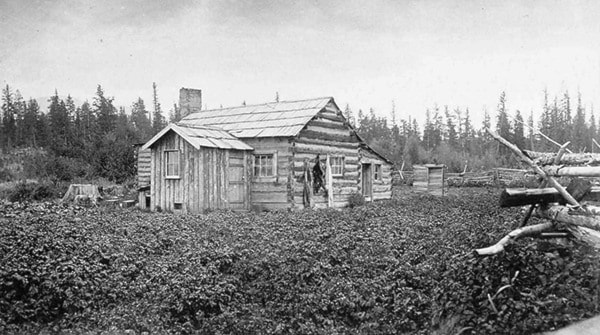Jim Cameron
Okay kids, let's kick things off with a short Provincial quiz. Question: 1) When did British Columbia join Confederation? 2) Who were the four men who traveled to Ottawa to negotiate the deal? So, how did you do? If you answered: 1) July 20, 1871 and 2) Joseph Trutch, Dr. John Helmcken, Dr. Robert W. Carrall and "that guy buried in the Cranbrook Old General Cemetery" then you would be absolutely right.
The "guy" in question is Henry Edward Seelye. Henry was born in St. George, N.B. in 1819. As with many of his neighbors he was from a family of United Empire Loyalists: former British colonists who left the U.S. when things went against them during the American Revolution. Henry married Lucretia Dawes Howe in 1843. Henry's sister Clementine married James Howe, Lucretia's brother, the same year. Lucretia and James Howe, it is worth noting, were the grandchildren of William and Mehitable Howe. William Howe is celebrated for his midnight ride along with Paul Revere (Longfellow's poem aside) from Boston to Lexington to warn of the impending arrival of the British army. Henry's mother was the daughter of loyalist Peter Clinch, a member of the New Brunswick House of Assembly and founder of the town of St. George. The families were well connected, especially along Loyalist lines.
Henry and Lucretia came to what is now B.C. about 1861. They travelled to the Cariboo and eventually made their way to Victoria where Henry, among other things, found work as a journalist with the British Colonist (the precursor of today's Victoria Times-Colonist) newspaper. Henry carried letters of introduction from S. L. Tilley and A.G. Archibald, both highly respected Fathers of Confederation with whom he was presumably connected through social/political ties. While employed at the Colonist he made the acquaintance of publisher David Higgins, editor John Robson, and former owner Amor De Cosmos among others. They too, had strong loyalist leanings and during the late 1860s were actively involved in the movement to see the numerous districts join the recently formed Dominion of Canada under one banner.
British Columbia was a perfect candidate for inclusion in Canada. It's wealth of resources and Pacific seacoast would be a boon for the Dominion. There was also a growing fear that the land might be annexed by the U.S. Still, the powers in control under British-appointed Governor James Douglas, (whose daughter was married to Dr. Helmcken of answer 2) did not seem inclined to take the appropriate steps required by Ottawa. Thus, much of the impetus was carried by the general public, journalists being among the most vocal. Enter Henry Seelye.
That Henry had connections back east is to be assumed. As mentioned, he certainly had the ear of Samuel L. Tilley, the Minister of Customs in Ottawa. During a large public meeting in Victoria in Jan. 1868, in order to debate the question of confederation, Henry read a telegram he received from Minister Tilley recommending immediate action. Henry made a motion that a committee be formed to further the cause. He himself was chosen as one of the members. He carried the campaign to Barkerville (another important centre at the time) six months later and was again added to their committee. In June 1870, Messrs. Trutch, Helmcken and Carrall headed to Ottawa to argue their case. Henry Seelye was asked by David Higgins to accompany them as a "People's Delegate," a logical choice given his connections and political convictions. Further, as a journalist, he could report on the proceedings, all expenses paid by Higgins. He was also asked, most importantly, to lobby Ottawa to allow B.C. to form a "Responsible Government." That is to say, a government elected by the people as opposed to one appointed by outside authorities. He proved successful in the task and thus ensured our present system of government (keeping in mind that there is a difference between Responsible Government and a government that is responsible). Needless to say, the trip was a success and the new province of British Columbia duly joined the Dominion of Canada the following year.
Henry's partners on the trip to Ottawa all went on to much success, both in politics and business. Messers Trutch and Carrall became the first Lt. Governor of the province and a senator, respectively, Helmcken a respected physician.
Henry was rewarded with a posting as a Customs Officer at the new port (so to speak) of Kootenay Landing in June, 1872: a log cabin on the grounds of what is now Baker Park (possibly near the area of the outdoor skating rink). He was to become the first "permanent" white resident and pioneer customs officer of Joseph's Prairie. The location was a suitable spot for a customs house intended to deal largely with gold miners due to its central location on the Dewdney Trail between the mining communities of Wild Horse and Perry Creeks, a point that all wagon trains entering the district must pass. Following his arrival he is reported by the British Colonist as saying he was so pleased with the country that he intended to bring his family out, which he subsequently did.
Sadly, Henry would not long savour the fruits of his labour. He died on Mar.27 1876, apparently from injuries suffered in the course of his work two years previously. Buried near his cabin he was later re-interred in the Old General Cemetery where he now rests, an important figure in our provincial history, often forgotten. A brass plaque marks his gravesite.
